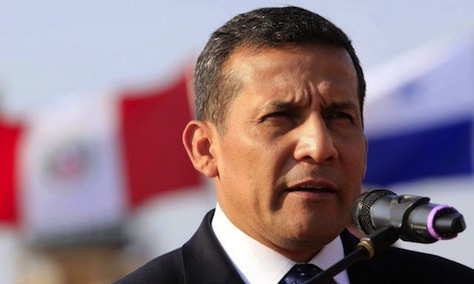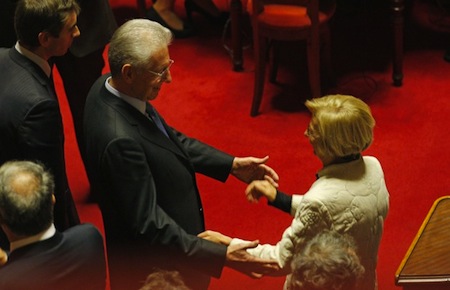It’s become a political law of gravity in Peru in the past 15 years that the popularity of its elected presidents drops as each five-year term ends.![]()
That’s irrelevant for the current president, Ollanta Humala, since Peruvian presidents aren’t eligible for reelection to two consecutive terms. But a week after opposition parties in Peru’s Congreso de la República (Congress of the Republic) forced Humala’s prime minister Ana Jara to step down amid a internal spying scandal, Humala was obligated to appoint the seventh prime minister of his administration.
Although the Peruvian president functions both as head of state and head of government, the prime minister heads the executive cabinet, and the appointment of Pedro Cateriano launched yet another reshuffle in the Humala administration as voters seem to be souring on Humala in the fourth of his five-year term. The Congress voted on March 30 to censure Jara in relation to allegations that Peru’s intelligence agency, the Dirección Nacional de Inteligencia (DINI), was spying on opposition politicians, journalists and businessmen.
Despite fears during the 2011 election that Humala, a leftist and former army officer, would lead Peru in a populist direction in the manner of socialist governments in Ecuador, Cuba and Venezuela, Humala instead pursued the same liberal, pro-market economic policies of all Peruvian administrations since the 1990s. Nevertheless, as commodities prices drop, GDP growth projections are falling in a country where gold, zinc and copper mining undergirded some of the fastest economic growth in the world throughout the 2000s. It’s the same problem that Chile, Peru’s Pacific neighbor to the south and also a prolific copper exporter, is facing. The difference is that GDP per capita is just over twice as high in Chile as in Peru, a country of just over 31 million that is still struggling to rise to the same level of development as Chile, Mexico and other leaders in Latin America. Nevertheless, Humala failed earlier this year to implement even a watered-down labor market reform designed to make it easier for young graduates to find work.
With growth forecasts slowing, however, it’s not enough that Humala has pursued continuity in economic policymaking. His failure to reform Peru’s economy, combined with an expected slowdown (if not an outright recession), will make it difficult for Humala’s allies to maintain power in 2016. In Peru, a country without firmly settled political parties, however, it’s a question whether Humala is still a man of the political left. Though liberal reformers believe Humala’s accomplishments are tepid, he’s now closer to Peruvian author Mario Vargas Llosa than the traditional left. For example, Humala has struggled throughout his administration to respond to the economic, labor rights and environmental complaints of Peru’s mining workers.
Gana Perú (Peru Wins), the leftist electoral coalition that formed to support Humala’s candidacy in 2011, claims that it will still field a candidate in the upcoming 2016 vote. The party remains the largest bloc in the unicameral Congress, having won 47 out of 130 seats at the last election. That number, however, has fallen due to defections over the years. Humala’s wife, Nadine Heredia, was forced to disavow any presidential ambitions in the middle of her husband’s term, and any majestic hopes evaporated with fresh allegations in February of corruption and money laundering, a familiar refrain in a country where former president Alejandro Toledo is also under a cloud of suspicion for corruption and may yet face criminal charges. Humala’s popular former interior minister, Daniel Urresti, was forced to resign in February after his indictment for the murder of Hugo Bustios in 1988 when Urresti was involved in the fight against Senedero Luminoso (Shining Path).
That means that the leaders in the 2016 field, for now, are the runners-up to Humala from the 2011 field. Polls today show that Keiko Fujimori, the daughter of former president Alberto Fujimori, leads the field, followed in second place by Pedro Pablo Kuczynski, a liberal who served as a former prime minister and economy minister. Fujimori’s candidacy was controversial in 2011 because of fears that she would pardon her father, who remains in prison on human rights abuses, potentially undermining the rule of law and encouraging impunity in the future. Humala has consistently refused to release Fujimori from prison, and the former dictator’s health has declined so much that the pardon issue may lack the same relevance in 2016. Proving the rule of the lingering unpopularity of Peruvian presidents, both Toledo and former president Alan García poll far behind. Fujimori’s record is still controversial in Peru, where supporters believe his economic reforms put Peru on the path to stable inflation and GDP growth and opponents point to his disrespect for democracy, the rule of law and human rights. His daughter, Keiko Fujimori, seems more committed to democratic Peru, though her frontrunner status in 2016 means that Peruvians could spend more time hand-wringing about the past than envisioning the future.
One possibility is Luis Castañeda, who returned to the mayor’s office in Lima last October and who has already run for the Peruvian presidency twice. The pragmatism and pro-development agenda of his first two terms as mayor between 2003 and 2010, appealed to the Peruvian business community. So far, however, Castañeda has spent much of his third term seemingly engaged in settling scores with his immediate predecessor, the more leftist Susana Villarán, instead of establishing a platform for a third presidential campaign in 2016.

